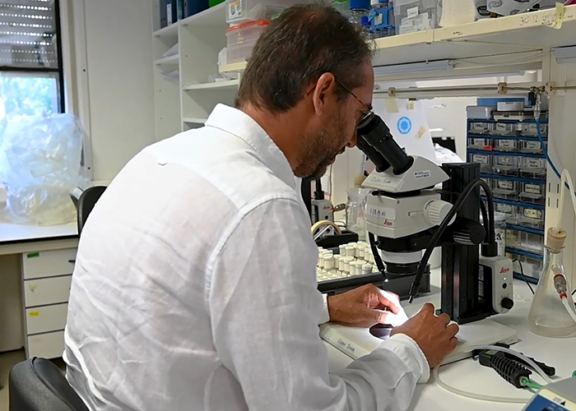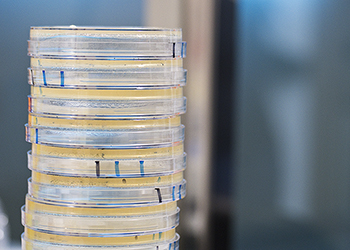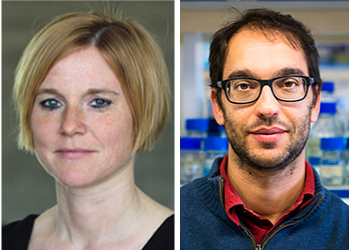
Interacções Hospedeiro Microrganismo
Luís Teixeira
Os organismos multicelulares e os microrganismos estão constantemente a interagir. Muitas destas interações são mutuamente benéficas. No entanto, os organismos multicelulares têm que impedir ativamente a invasão de micróbios oportunistas ou manifestamente patogénicos.
O grupo de investigação interações hospedeiro-microrganismo está a estudar a interação do organismo modelo Drosophila melanogaster com diferentes microrganismos, em particular com os intracelulares. A D. melanogaster tem sido utilizada com sucesso como sistema modelo para estudar a imunidade inata contra muitos patógenos.
Tem sido demonstrado recentemente que existem vias de imunidade inata contra os vírus entre insetos e mamíferos. O grupo de investigação está a estudar os mecanismos de resistência a vírus na mosca da fruta.
Curiosamente, descobriram que a bactéria intracelular Wolbachia confere resistência aos vírus ARN na D. melanogaster. O laboratório quer compreender a base molecular desta resistência induzida.
Finalmente, o grupo está interessado na interação entre a Drosophila e a Wolbachia. Estes endosimbiontes são duas das bactérias intracelulares mais disseminadas do mundo, mas pouco se sabe sobre como a nível molecular, os hospedeiros controlam a Wolbachia e a Wolbachia manipula os hospedeiros.
Financiamento Membro


Projetos
SymbNET is a European network for research on host-microbe symbiosis, funded by the European Union’s Horizon 2020 research and innovation programme. Animals and plants live with microbial communities that have a strong impact on their development, physiology, and evolution. Thus, understanding these symbiotic interactions is a crucial axis of research in Fundamental Biology and Health Sciences. This field requires multidisciplinary, highly skilled teams and collaborative research.
SymbNET will create a European network in the use of Genomics and Metabolomics in Host-Microbe Symbiosis research. It will bring together a consortium of leaders in the field that present a wide range of expertise, technological knowledge, scientific questions and approaches in Host-Microbe Symbiosis. SymbNET will promote the transfer of knowledge and collaborations through programs of Researchers and Staff visit exchanges, collaborative projects, sponsoring the use of new technologies, organizing scientific meetings, workshops, PhD Summer Schools, and a European meeting on Host-Microbe Symbiosis. There will be specific actions targeted at Early Stage Researchers to promote their research, training, mentoring, and networking, ensuring gender equality in participation.
SymbNET will establish a European consortium in Host-Microbe Symbiosis, capacitate the participating institutions, and promote this crucial growing area of research at the local and international level.

Publicações
- Duarte EH, Carvalho A, López-Madrigal S, Costa J, Teixeira L (2021) Forward genetics in Wolbachia: Regulation of Wolbachia proliferation by the amplification and deletion of an addictive genomic island.. PLoS Genetics 17(6):e1009612.
- Faria, V. G., Martins, N. E., Magalhães, S., Paulo, T. F., Nolte, V., Schlötterer, C., Sucena, E., Teixeira, L. (2016) Drosophila Adaptation to Viral Infection through Defensive Symbiont Evolution. PLoS Genetics 12(9):e1006297
- Gutzwiller, F., Carmo, C. R., Miller, D. E., Rice, D. W., Newton, I. L. G., Hawley, R. S., Teixeira, L., Bergman, C.M. (2015) Dynamics of Wolbachia pipientis Gene Expression Across the Drosophila melanogaster Life Cycle. G3; Genes|Genomes|Genetics 5(12):2843–2856
- Chrostek, E., Teixeira, L. (2015) Mutualism Breakdown by Amplification of Wolbachia Genes. PLoS Biology 13(2):e1002065
- Chrostek, E., Marialva, M. S. P., Yamada, R., O'Neill, S. L., Teixeira, L. (2014) High Anti-Viral Protection without Immune Upregulation after Interspecies Wolbachia Transfer. PLoS ONE 9(6):e99025
- Martins, N. E., Faria, V. G., Nolte, V., Schlotterer, C., Teixeira, L., Magalhães, S., Sucena, É. (2014) Host adaptation to viruses relies on few genes with different cross-resistance properties. PNAS 111(16):5938–5943
- Martinez, J., Longdon, B., Bauer, S., Chan, Y.-S., Miller, W.J., Bourtziz, K., Teixeira, L., Jiggins, F.M. (2014) Symbionts commonly provide broad spectrum resistance to viruses in insects: a comparative analysis of Wolbachia strains. PLoS Pathog 10(9):e1004369
- Ferreira, A.G, Naylor, H., Esteves, S.E., Pais, I.S., Martins, N.E., Teixeira, L. (2014) The Toll-Dorsal pathway is required for resistance to viral oral infection in Drosophila. PLoS Pathog 10(12):e1004507
- Martins, N. E., Faria, V. G., Teixeira, L., Magalhães, S., Sucena, É. (2013) Host Adaptation Is Contingent upon the Infection Route Taken by Pathogens. PLoS Pathogens 9(9):e1003601
- Chrostek, E., Marialva, M. S. P., Esteves, S. S., Weinert, L. A., Martinez, J., Jiggins, F. M., Teixeira, L. (2013) Wolbachia Variants Induce Differential Protection to Viruses in Drosophila melanogaster: A Phenotypic and Phylogenomic Analysis. PLoS Genetics 9(12):e1003896
- Teixeira, L., Ferreira, A., Ashburner, M. (2008) The Bacterial Symbiont Wolbachia Induces Resistance to RNA Viral Infections in Drosophila melanogaster. Plos Biol 6(12):e2


